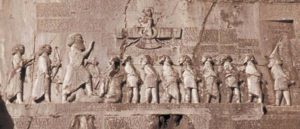Cuneiform Secrets Revealed, Ira Maurice Price, Monuments and the Old Testament, The Chrisitan Culture Press, Chicago 1899.
The wedge-writing continued for long ages to be an unsolved mystery. The discoveries of Botta and Layard in the mounds at Khorsabad and Nimroud were contemporaneous with another and equally or more remarkable event.
Oriental scholars in Germany, France, Scandinavia, and other countries had set their wits to solve the wedge-language of old Persia. By shrewd guessing only did they arrive at a few results of value. No very substantial progress was made, however, until a young Englishman, an officer in the Persian army, Henry C. Rawlinson, made a discovery in 1835 in the Zagros Mountains. Here he found a limestone mountain rising out of the plain to a height of 1,700 feet.
One side of this mass was almost perpendicular in form. About 350 feet above the base on this perpendicular side, Rawlinson could see a large space which had been carefully hewn off and polished. Upon this prepared surface he could also descry a large bas-relief representing a king, before whom stood a long line of captives bound neck to neck with a rope. Adjacent to this great group were several columns of cuneiform inscriptions. Rawlinson thought that in ancient times there might have been a scaffolding of some kind so that the passer-by might reach and read the inscriptions; but at this time they were too high and too inaccessible. Rawlinson’s perseverance over slippery and dangerous places finally brought him to the narrow ledge at the foot of the inscriptions. This ledge, about fourteen inches wide, had been made when the large surface had been hewn and smoothed off, and the artistic work done. Rawlinson resolved at once to copy these wonderful columns of inscriptions. The narrowness of the ledge, and the disappearance of a part of it by the ravages of time, and the fearful chasm below him of 350 feet, put him in peril. Some of the inscriptions he could copy from the ledge, for others he climbed a ladder, the foot of which was held on the fourteen inch ledge by an attendant. But even this perilous task could not be carried out above a space from which the ledge had been worn away. Various schemes were devised and native help employed to accomplish his purpose. For a time he was suspended in a swing in front of the columns of writing. Suffice it to say that only after most painstaking effort and dangerous risks, at intervals during four years, was Rawlinson able to complete the copying of these columns of wedge-writing.
37. As soon as he discovered the probable value of the inscriptions, and that he had not one language but three in his possession, he set about industriously studying the Sanskrit, Zend, and Pehlevi languages, that thereby he might be the better equipped for his task of translating. Some smaller Persian inscriptions found at Persepolis and other points were also used to advantage. Being familiar with modern Persian, he was also in a peculiar sense ready for his work. As other scholars who had at various times tackled old Persian inscriptions, Rawlinson selected as a basis for investigation the names Darius, Xerxes, and Hystaspes. These same names occurred on a number of inscriptions, and by ingenious guesses he discovered some of the letters of which the names were constituted. Then by testing the values of these letters in other words the meanings of which were known to him as a modern Persian scholar, Rawlinson succeeded finally in translating the five columns of old Persian cuneiform writing- nearly 400 lines. Ten years after his discovery at Behistun, he sent his translation to Europe. In 1841, the text, translation, and a commentary appeared in the Journal of the Royal Asiatic Society.
Rawlinson tells us that these inscriptions were cut here by order of Darius I., king of Persia, about 515 B. C. They relate how, while Darius was still occupied in the reformation of the national faith, an insurrection broke out in Susiana; that the chief ring leader was seized without the employment of any military force; that there was also a revolt in Babylon of such a determined character that Darius was obliged to lead his own troops to put it down. Other valuable historical information is also contained in this old document.
38. On the supposition that the other two inscriptions told the same story, scholars began to attempt to read them. Very soon the second tongue, the Median or Susian, began to yield its secrets. Then the third series of columns, the Babylonian, was forced to give up its hidden treasures. This Behistun group was found to sustain the same relation to the cuneiform languages of Babylonia that the Rosetta stone sustained to the tongues of ancient Egypt. It was the key to its ancient life, people, and government.
But, as in all cases of great advance in anyone department, there were doubters and skeptics. To make a final test of scholars’ ability to read and interpret these inscriptions, four men, Rawlinson (H. C.), the discoverer and translator of the Old Persian inscription; Hincks (Edw.), an Irishman; Oppert (J.), a Frenchman, still living; Talbot (H. F.), an Englishman, met in London in 1857. The trustees of the British Museum gave each a fine lithographic copy of a long historical inscription, and asked that he work independently and present at a specified time the results of his work. At the given date all appeared and compared results. To the great surprise and profound satisfaction of everyone, their translations agreed substantially from beginning to end. The triumph was almost incredible; the victory was complete. This new philological solution was the greatest achievement ever made in the field of language or archaeology. It was as great a discovery in the field of history and philology as the telegraph in the commercial world.
p. 56-60




